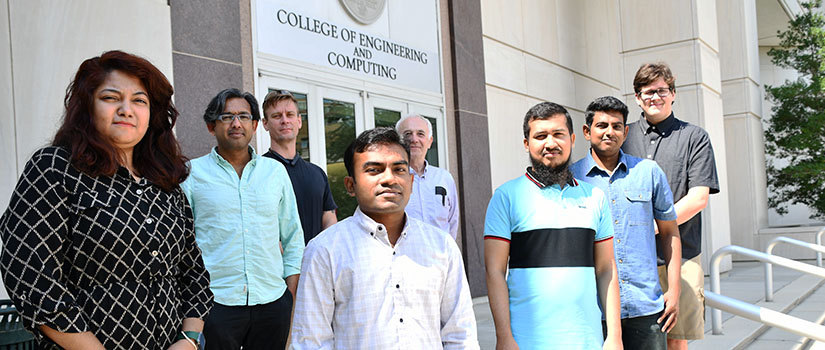MVS Chandrashekhar (back left), Grigory Simin (back right) are joined by their group of research assistants.
Extreme materials have usually led to improvements in the quality of life. For example, boron nitride is a popular extreme material used with X-Rays. While these materials endure extreme conditions such as high temperatures or loading rates, they can be transformed with distinctive characteristics that are utilized in applications such as healthcare and manufacturing.
Electrical Engineering Associate Professor MVS Chandrashekhar has done previous research with boron nitride, but he is currently working on a project with another extreme material with healthcare applications.
Chandrashekhar’s three-year, $500,000 National Science Foundation (NSF)-sponsored research, “Laser Lifted Off Ill-Nitride Devices & Circuits on Engineered Substrates,” began in mid-August. His co-PIs are Department of Electrical Engineering colleagues Asif Khan and Grigory Simin.
Aluminum gallium nitride is a semiconductor extreme material used in the development of products such as lasers and LEDs. Its ultrawide bandgap makes it ideal for compact power and low-leakage applications in consumer electronics. Power devices based on ultra-wide bandgap materials are considered the next generation, compact and uncooled power electronics for consumer applications, which include electric vehicles.
A specialized application could be something to measure heart rate by the size of the wave coming from a heartbeat. It’s a new type of sensor that can be correlated with other biometric sensors, even ones on phones.
- MVS Chandrashekhar
But increased bandgap is limited by substrates, which provide interconnections to form an electric circuit and cool components while growing thin, active layers. Chandrashekhar’s research aims to transfer active layers to specific engineered substrates for utilizing the full potential of aluminum gallium’s properties in ultra-compact devices. The new applications beyond power electronics devices are primarily in healthcare, including heart rate and blood pressure sensors.
“We're trying to break into the healthcare side since it’s a big application. The human body is a very extreme environment,” Chandrashekhar says.
Chandrashekhar plans to test this process by transferring aluminum gallium heat using Laser Lift-off (LLO) processing technology. By exposing the inside of a material to a high-powered laser to heat and decompose it, the material is then separated, which serves as the base point for detaching. The goals are to eliminate thermal and electrical resistances, and the mass of the substrate, and transfer heat to copper foils or commercial polyethylene terephtalate, which is a lightweight plastic widely used for packaging foods and beverages. This will lead to integrating III-nitrides, which are compound semiconductor materials with superior properties and well-developed growth techniques that are considered ideal for ultra-compact devices.
“This project will develop an understanding of bandwidth limiting defects induced by LLO and packaging in low-leakage circuits. Looking at defects from other case studies will also determine the ultimate bandwidth and power handling capabilities of aluminum gallium nitride devices,” Chandrashekhar says.
“By removing the substrate, the predicted limits will be tested and allow measurement of the fundamental properties of these materials.”
Removing substrates is essential to improving electrical and thermal performance of aluminum gallium nitride devices. With the risk of creating bandwidth limiting traps to the III-nitrides, Chandrashekhar plans to implement a thick layer for surviving the heat transfer. Transferring heat to engineered substrates creates new functionalities, such as in-screen power amplifiers.
“Even with the potential risk of operating at low frequency, applications such as heart rate monitoring by photoplethysmography (optical technique) will be possible in a much smaller footprint using III-nitrides compared to commercial fitness trackers,” Chandrashekhar says.
Chandrashekhar also intends to utilize a strain sensor, which changes resistance with applied force. It then converts any force or pressure into a change in electrical resistance that can be measured, which is known as gauge factor. The higher the gauge factor, the more the change in resistance.
“We need precise measurements for metal strain gauges like blood pressure monitors. Those strain gauges are a gauge factor of two, so they can be made smaller,” Chandrashekhar says. “A specialized application could be something to measure heart rate by the size of the wave coming from a heartbeat. It’s a new type of sensor that can be correlated with other biometric sensors, even ones on phones.”
Chandrashekhar also says that what may appear as simple device structures, such as the polyethylene terephtalate lightweight plastic, could be used for measuring blood pressure in consumer wearables.
“A lot of big companies are working on this stuff, so I think we need a new sort of materials technology,” Chandrashekhar says. “There's a need to develop startups to try out new concepts. Current blood pressure monitors are not great for consumers but useful in the lab. For consumers, there's no way to measure blood pressure continuously since it’s always a snapshot measurement at the doctor’s office.”
Chandrashekhar’s project brings together some of his previous research. Just prior to the COVID-19 pandemic, Assistant Professor Bridget Armstrong from the University of South Carolina Arnold School of Public Health asked him to build a fitness tracking device for children. This led to other projects, including his current research.
“It's a wide-open parameter space. Working with Public Health forces us to understand the end application very intimately. They need the numbers to be accurate within a few percent, and working with healthcare people has been an eye-opening experience and showed more opportunities,” Chandrashekhar says.
Chandrashekhar admits that power electronic research can be saturated at times with similar projects. Competing against larger companies is difficult, so he aims to continue to pursue research involving extreme materials and new processes.
“The liftoff technology was an example of something different that works. If we can transfer the lift off into the plastic, that would open a lot of opportunities,” Chandrashekhar says. “You mitigate risk with some of the more traditional engineering processes and use that towards a new science or application.”
